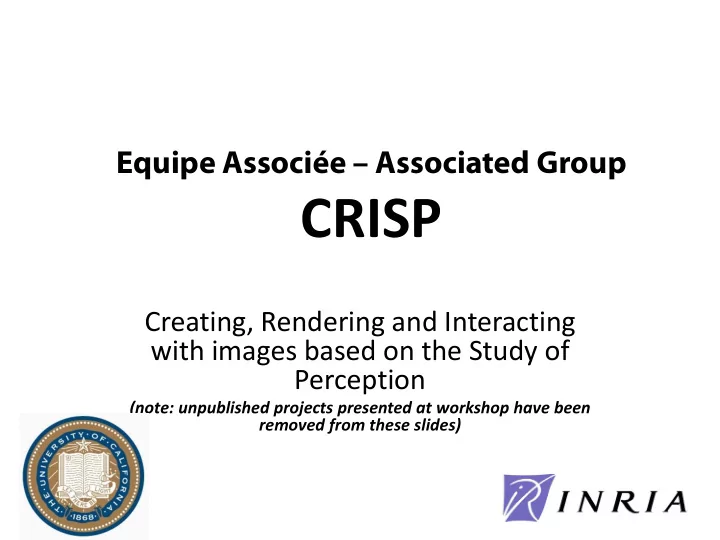

Equipe Associée – Associated Group CRISP Creating, Rendering and Interacting with images based on the Study of Perception (note: unpublished projects presented at workshop have been removed from these slides)
The People • UC Berkeley: – Maneesh Agrawala (Computer Science/Graphics & Interaction) – Ravi Ramamoorthi (Computer Science/Graphics) – Marty Banks (Vision Science) • INRIA (REVES Inria Sophia-Antipolis Méditérranée) – George Drettakis (Graphics) – Adrien Bousseau (Graphics) – past postdoc at UCB • 4-6 Ph.D. students and 2-3 Postdocs potentially involved
Realistic and Expressive Rendering
Materials in Computer Graphics
Lighting and Shadows
Main Objectives • Create, render and interact based on the study of human perception • Research directions: – Perception: how do people perceive images, both realistic and “expressive” ? – Rendering: plausible wrt to user intent & allocate resources on perceptually important visual effects – Interaction: Facilitate content creation via novel user interfaces for novice and professional users.
Scientific goals • Interpreting images • Creating and manipulating images • Rendering images
Scientific Goals: Interpreting images • Study how people perceive lighting, material and geometry in an image • Important both for drawings and illustrations and for rendering • Allow the development of novel drawing interfaces and efficient rendering algorithms
Interpreting Images • Perception and illustration of materials Glossy plastic Glass Chrome
Scientific Goals: Creating and manipulating images • Complex interactions between geometry , material and lighting parameters result in interfaces that are hard-to-use • Identify which image components are perceptually important • Propose novel interaction paradigms and image creation/manipulation algorithms based on these results
Interfaces for Content Creation
Scientific Goals: Rendering Images • Identify which approximations users tolerate well • Develop new, more efficient algorithms exploiting perceptually “appropriate” approximations • Enhance the depiction of geometry, materials and lighting without degrading quality
Rendering images • Which approximation is more tolerable ?
Talk Overview • Projects in progress • Future projects • Conclusions
Ongoing Projects • Interpreting images: – Perception of materials with stereo and parallax – Perception of materials in “expressive” renderings • Creating and manipulating images: – Lighting design for material depiction • Perception: – Crowdsourcing for perceptual studies
Lighting Design for Material Depiction Adrien Bousseau, Emmanuelle Chapoulie REVES – INRIA Sophia Antipolis Ravi Ramamoorthi, Maneesh Agrawala UC Berkeley To be presented at Eurographics Symposium on Rendering 2011
Lighting affects material appearance Our optimized lighting Poor lighting emphasizes materials de-emphasizes materials
Lighting design principles Transparent (glass, ice) Subsurface scattering Asperity (velvet, fur) High contrast at (wax, marble, organic) High contrast highlights contours Thin parts brighter at grazing angle Shiny (metal, plastic, chrome) Fresnel (glass, plastic, varnish) High contrast edges in reflections High contrast reflections at grazing angle
Optimal lighting Transparent (glass, ice) Subsurface scattering Asperity (velvet, fur) High contrast at (wax, marble, organic) High contrast highlights contours Thin parts brighter at grazing angle Shiny (metal, plastic, chrome) Fresnel (glass, plastic, varnish) High contrast edges in reflections High contrast reflections at grazing angle
Best orientation of real lighting
Best orientation of real lighting Transparent (glass, ice) Subsurface scattering Asperity (velvet, fur) High contrast at (wax, marble, organic) High contrast highlights contours Thin parts brighter at grazing angle Shiny (metal, plastic, chrome) Fresnel (glass, plastic, varnish) High contrast edges in reflections High contrast reflections at grazing angle
Worst orientation of real lighting Transparent (glass, ice) Subsurface scattering Asperity (velvet, fur) High contrast at (wax, marble, organic) High contrast highlights contours Thin parts brighter at grazing angle Shiny (metal, plastic, chrome) Fresnel (glass, plastic, varnish) High contrast edges in reflections High contrast reflections at grazing angle
Conclusions • General orientations – Perception-oriented studies which advance understanding: true multidisciplinary research – Advance research in graphics, (human) vision and human-computer interaction – Develop new algorithms for rendering and interaction, capitalize on perceptual studies
Recommend
More recommend